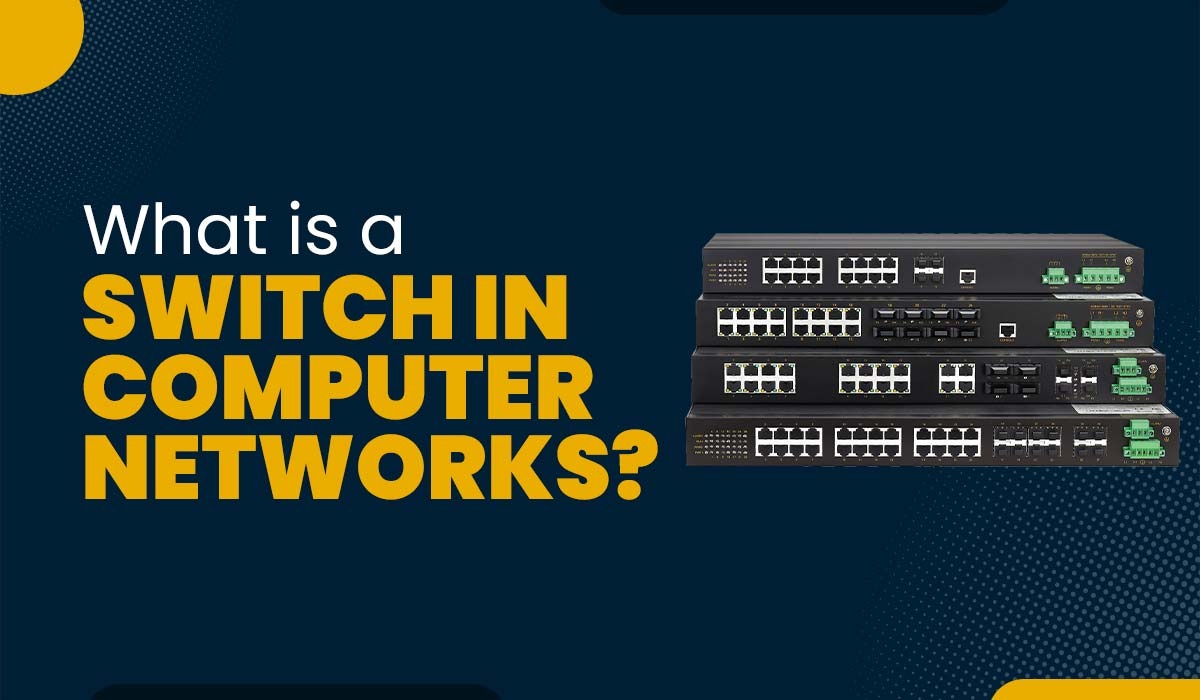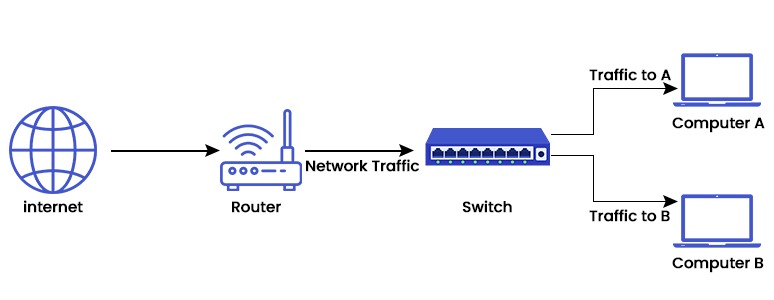What is Switch in Computer network?

A Switch in Computer Network is a networking device that assist in connecting multiple computers or network devices. They play a significant role in the creation and management of networks as well as enhancing their performance, security, and scalability. By learning about switches, we get insight about how networks function and how we can optimize them to suit network requirements. In this blog, we will explain what a switch in computer networks is, their history, use of switches in networking, and their advantages and disadvantages. Switches form the backbone of networking and are one of the main building blocks of Local Area Networks (LAN). These are some of the basic devices that a network engineer must be familiar with and are covered under the CCNA Training. Let’s first understand what switches are. A switch acts as a network device that receives data packets from connected devices and directs them to their intended destination based on the information contained in the packet header. Generally, a switch operates at the OSI model‘s data link layer (layer 2). Further switches can identify and process MAC addresses associated with devices. Switches can also operate at the OSI model’s network layer (layer 3), allowing them to handle IP addresses and route packets between networks. Below we have shown the switch with the help of an image. The initial development of switches took place during the 1980s and early 1990s as an improvement over hubs. Hubs are the devices that broadcast all incoming data packets to every connected device. Hubs often result in network congestion and collisions since multiple devices could attempt to transmit data. Switches resolved this issue by establishing individual collision domains for each port, which decreased the occurrence of collisions and improved the allocation for every device. Additionally, switches introduced capabilities like VLANs, QoS, security measures, and network management tools, thereby enhancing the functionality and performance of networks. Now that we have a basic understanding of switches, let’s now discuss what are some of the uses of switches. A Switch in Computer Network can be used for different purposes, some of which are: We have discussed the history of switches along with its different uses in a network. Below, we have discussed the functioning of a switch. The functioning of a switch involves receiving data packets from one or multiple source devices and then forwarding them to one or more destination devices based on their MAC address. The following steps outline how a switch operates. Overall, this process allows switches to effectively manage network traffic by directing packets towards their intended destinations based on their MAC addresses. Let’s now discuss the different types of switches in networking. There are different types of switches in networking. We have explained the different types in detail. An unmanaged switch is an inexpensive switch that doesn’t require any configuration or management. It can be used out of the box without any user intervention. Unmanaged switches are ideal and are used for networks that don’t require control or customization. A managed switch is an advanced and costly option with various configuration and management features. Users can modify a managed switch through a web interface, command line interface (CLI), or network management software. These switches are best suited for networks that require control and customization. A smart switch falls in between a managed and unmanaged switch. It offers some configuration and management features. But not as many as a managed switch. Users can modify settings on a switch using either a web interface or network management software, making it suitable for medium-sized networks that need some level of control and customization. Another type of switch is layer 2 switches, which operate at the data link layer of the OSI model. The primary purpose of these switches is to process the MAC addresses of devices. A Layer 2 switch can route packets within a network or VLAN. A layer 3 switch is a type of switch that operates at both the data link layer and the network layer within the OSI model. It has the capability to identify and process both MAC addresses and IP addresses of devices. This means that a layer 3 switch can efficiently forward packets within or between networks or VLANs. A PoE or Power over Ethernet switch is a type of switch in computer network that is mainly used to supply power as well as data to other devices over Ethernet cables. This simplifies the installation and reduces the cost of wiring for devices such as IP cameras, wireless access points, or VoIP phones. These are the various types of Switch in Computer Networks. A computer switch is a type of networking device that helps connect different types of devices within a network and forwards data packets to the intended device based on MAC address. Both the switch and hub are networking devices. Switch connects devices in a network and forwards data to the correct destination. Hub connects devices in a network but broadcasts data to all devices. Although Switch and Hub works similarly, there are various differences between Hub and Switch. A switch is a type of networking device that assists in connecting multiple devices as well as in transferring packets to the destination device. A network switch is used for different purposes. One such example is a switch that can be used in order to connect devices such as computers, printers, and many others and share data between these devices. A switch is a networking device that connects multiple devices on a computer network and forwards data packets to the destination device based on the MAC address of the packet. In this blog, we have discussed what switch in computer network is, their history, different uses of switches, how switches operate, and different types of switches.Introduction
What is Switch in Computer Networks?

History of Switches
Different Uses of Switches in Networking
Working of Switch in Computer Network
Types of Switches in Networking
Unmanaged Switch
Managed Switch
Smart Switch
Layer 2 Switch
Layer 3 Switch
PoE Switch
Frequently Asked Questions
Q1. What is the computer switch?
Q2. What is switch and hub?
Q3. What is a switch and its functions?
Q4. What is a network switch example?
Conclusion







